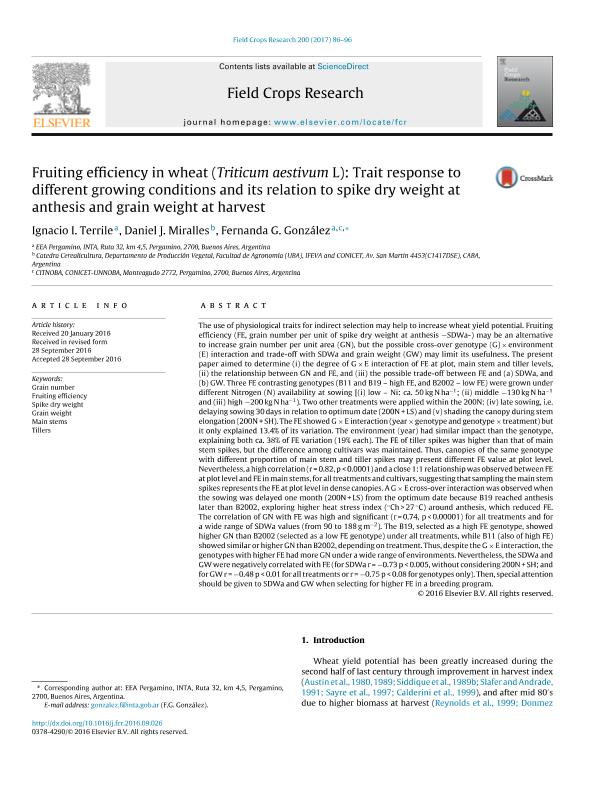Mostrar el registro sencillo del ítem
dc.contributor.author
Terrile, Ignacio Ismael

dc.contributor.author
Miralles, Daniel Julio

dc.contributor.author
González, Fernanda Gabriela

dc.date.available
2018-12-04T22:23:37Z
dc.date.issued
2017-02
dc.identifier.citation
Terrile, Ignacio Ismael; Miralles, Daniel Julio; González, Fernanda Gabriela; Fruiting efficiency in wheat (Triticum aestivum L): Trait response to different growing conditions and its relation to spike dry weight at anthesis and grain weight at harvest; Elsevier Science; Field Crops Research; 203; 2-2017; 86-96
dc.identifier.issn
0378-4290
dc.identifier.uri
http://hdl.handle.net/11336/65816
dc.description.abstract
tThe use of physiological traits for indirect selection may help to increase wheat yield potential. Fruitingefficiency (FE, grain number per unit of spike dry weight at anthesis −SDWa-) may be an alternativeto increase grain number per unit area (GN), but the possible cross-over genotype (G) × environment(E) interaction and trade-off with SDWa and grain weight (GW) may limit its usefulness. The presentpaper aimed to determine (i) the degree of G × E interaction of FE at plot, main stem and tiller levels,(ii) the relationship between GN and FE, and (iii) the possible trade-off between FE and (a) SDWa, and(b) GW. Three FE contrasting genotypes (B11 and B19 ? high FE, and B2002 ? low FE) were grown underdifferent Nitrogen (N) availability at sowing [(i) low ? Ni: ca. 50 kg N ha−1; (ii) middle −130 kg N ha−1and (iii) high −200 kg N ha−1). Two other treatments were applied within the 200N: (iv) late sowing, i.e.delaying sowing 30 days in relation to optimum date (200N + LS) and (v) shading the canopy during stemelongation (200N + SH). The FE showed G × E interaction (year × genotype and genotype × treatment) butit only explained 13.4% of its variation. The environment (year) had similar impact than the genotype,explaining both ca. 38% of FE variation (19% each). The FE of tiller spikes was higher than that of mainstem spikes, but the difference among cultivars was maintained. Thus, canopies of the same genotypewith different proportion of main stem and tiller spikes may present different FE value at plot level.Nevertheless, a high correlation (r = 0.82, p < 0.0001) and a close 1:1 relationship was observed between FEat plot level and FE in main stems, for all treatments and cultivars, suggesting that sampling the main stemspikes represents the FE at plot level in dense canopies. A G × E cross-over interaction was observed whenthe sowing was delayed one month (200N + LS) from the optimum date because B19 reached anthesislater than B2002, exploring higher heat stress index (◦Ch > 27◦C) around anthesis, which reduced FE.The correlation of GN with FE was high and significant (r = 0.74, p < 0.00001) for all treatments and fora wide range of SDWa values (from 90 to 188 g m−2). The B19, selected as a high FE genotype, showedhigher GN than B2002 (selected as a low FE genotype) under all treatments, while B11 (also of high FE)showed similar or higher GN than B2002, depending on treatment. Thus, despite the G × E interaction, thegenotypes with higher FE had more GN under a wide range of environments. Nevertheless, the SDWa andGW were negatively correlated with FE (for SDWa r = −0.73 p < 0.005, without considering 200N + SH; andfor GW r = −0.48 p < 0.01 for all treatments or r = −0.75 p < 0.08 for genotypes only). Then, special attentionshould be given to SDWa and GW when selecting for higher FE in a breeding program.
dc.format
application/pdf
dc.language.iso
eng
dc.publisher
Elsevier Science

dc.rights
info:eu-repo/semantics/openAccess
dc.rights.uri
https://creativecommons.org/licenses/by-nc-nd/2.5/ar/
dc.subject
Grain Number
dc.subject
Fruiting Efficiency
dc.subject
Spike Dry Weight
dc.subject
Main Stems And Tillers
dc.subject.classification
Agricultura

dc.subject.classification
Agricultura, Silvicultura y Pesca

dc.subject.classification
CIENCIAS AGRÍCOLAS

dc.title
Fruiting efficiency in wheat (Triticum aestivum L): Trait response to different growing conditions and its relation to spike dry weight at anthesis and grain weight at harvest
dc.type
info:eu-repo/semantics/article
dc.type
info:ar-repo/semantics/artículo
dc.type
info:eu-repo/semantics/publishedVersion
dc.date.updated
2018-10-23T19:56:35Z
dc.journal.number
203
dc.journal.pagination
86-96
dc.journal.pais
Países Bajos

dc.journal.ciudad
Amsterdam
dc.description.fil
Fil: Terrile, Ignacio Ismael. Instituto Nacional de Tecnología Agropecuaria. Centro Regional Buenos Aires Norte. Estación Experimental Agropecuaria Pergamino; Argentina
dc.description.fil
Fil: Miralles, Daniel Julio. Consejo Nacional de Investigaciones Científicas y Técnicas. Oficina de Coordinación Administrativa Parque Centenario. Instituto de Investigaciones Fisiológicas y Ecológicas Vinculadas a la Agricultura. Universidad de Buenos Aires. Facultad de Agronomía; Argentina. Universidad de Buenos Aires. Facultad de Agronomía. Departamento de Producción Vegetal. Cátedra de Cerealicultura; Argentina
dc.description.fil
Fil: González, Fernanda Gabriela. Consejo Nacional de Investigaciones Científicas y Técnicas. Centro de Investigaciones y Transferencia del Noroeste de la Provincia de Buenos Aires. Universidad Nacional del Noroeste de la Provincia de Buenos Aires. Centro de Investigaciones y Transferencia del Noroeste de la Provincia de Buenos Aires; Argentina. Instituto Nacional de Tecnología Agropecuaria. Centro Regional Buenos Aires Norte. Estación Experimental Agropecuaria Pergamino; Argentina
dc.journal.title
Field Crops Research

dc.relation.alternativeid
info:eu-repo/semantics/altIdentifier/doi/http://dx.doi.org/10.1016/j.fcr.2016.09.026
dc.relation.alternativeid
info:eu-repo/semantics/altIdentifier/url/https://www.sciencedirect.com/science/article/pii/S0378429016303987
Archivos asociados
